Astronomy 125: Stars in the Interstellar Medium
Archive of Assignments
Week 14
posted 4/24
This week's assignment is about the multiphase interestellar medium. We'll be reading several papers (see links below), and discussing the ideas in them. Note that we'll begin seminar on Wednesday by going over the four supernova problems from last week (shocks).
Here is the reading for this week: (1) Field, Goldsmith, and Habing, "Cosmic Ray Heating of Interstellar Gas," Ap.J.L., 155, L149; (2) McKee, "The Multiphase Interstellar Medium," ASP Conf. Ser., 80, 292, 1995; (3) Cox, "Overall Models of the Interstellar Medium," 11th IAP Astrophysics Mtg., 233, 1996; (4) Cox, "Crumbling Canons," Nature, 375, 185, 1995; (5) Bland-Hawthorn and Reynolds, "The Intercloud Medium" (also linked below); (6) McKee, "Global Structure of the Multiphase Interstellar Medium," 11th IAP Astrophysics Mtg., 223, 1996.
Here is some interesting information about aspects of the multiphase ISM paradigm (note that that third item is the 5th reading in this week's assignment):
|
Meeting about the multiphase ISM from a few years ago. You can check out the talk titles ("program" link and also the abstracts, if you wish).
|
Note that there is nothing to hand in ahead of time this week, but you should bring your written answers/notes (related to the bullet-point questions at the end of the assignment) to seminar. We'll have student presentations for the four left-over supernova problems from last week and presentations for each of the first three papers for this week. I've grouped the last two supernova questions together, so we have six presentations; one for each student. Get in touch with me anytime to request one of the six presentation topics.
Week 13
posted 4/16
This week's assignment is about shocks - a fundamental physics phenomenon, with numerous applications in stellar and interstellar astrophysics. We'll take a supernova explosion driving a shock wave into the surrounding interstellar medium, creating an expanding and shock-heated supernova remnant, as our example application.
Note that there are several problems for you to hand in on Tuesday.
The Harvard notes are here:
sec. 2.2: thermodynamics [pdf]
sec. 4.1, 4.2: fluid equations and sound waves [pdf]
sec. 4.3, 4.4: shock jump conditions and shock structures [pdf]
sec. 4.5: strong spherical shocks [pdf]
Dyson and Williams is on the honors reserve shelf at Cornell.
Take a look at these shock images and descriptions:
simple animation of the sound-wave to shock-wave transition
snapshots and movies from simulations of shock waves
Cassiopeia A supernova remnant in X-rays
APOD images
shocks are subject to instabilities
like the Kelvin-Helmholz instability
schlieren photography of shocks
Week 12
posted 4/11
Please post any questions you have about the readings on this week's Moodle forum.
posted 4/10
This week's assignment is a continuation of our work last week on H II regions. We'll reread Ch. 3 of Osterbrock (and Catherine and Andrew will give their presentations from this past week, and we'll go over the last four worked problems from last week's assignment). We'll also read a (short) section from another book (Bowers & Deeming) that explains density-sensitive line ratios (and we've got one new problem out of that book). But the bulk of your reading is of a review paper on the Orion Nebula.
The Bowers & Deeming reading is available as a pdf and the O'Dell review article on the Orion Nebula is available on ADS.
Note that there are two problems for you to hand in ahead of time this week.
Week 11
posted 4/5
Take a look at these two classic H II regions (Orion on the left and the Eagle Nebula on the right).

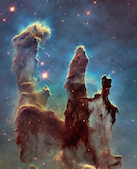
Each image is linked to the APOD description. Please read them, and then search on APOD for other images of these two H II regions. (I've already asked you in the assignment to do this for Orion, M 42). Send me your favorites. Look, especially, for images in other wavelengths (primarily IR - the Eagle's "Pillars of Creations" are quite spectacular in the IR; given that their optical properties are primarily due to dust, how do you expect the Pillars to look in the IR?). Note that both the Eagle and Orion are blister H II regions, relatively thin but wide bubbles of ionized gas right on the surface of a dense molecular cloud (much as you might have a thin, circular blister on the surface of your finder or toe). The very different appearances we see are due to the fact that we're viewing Orion nearly face-on and the Eagle nearly side-on.
And, please watch this movie of a fly-through of a model/reconstruction of the Orion Nebula – I recommend the larger, higher-resolution version, but it is a very big file:
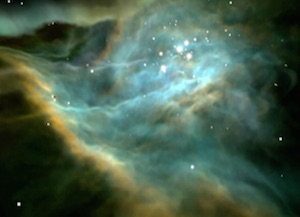
Finally, look over my comments on Osterbrock Ch. 1 on the Moodle forum and post your own questions (about any of the reading) there.
Week 10
posted 3/27
This week's assignment is about dust. You'll be reading things from Dyson and Williams and also two conference papers on the topic.
Here is a pdf of the Dyson and Williams reading. And the two papers: ASP Conf. Ser. 80, 133 and ASP Conf. Ser. 357, 305.
As part of this week's assignment, have a look at these dust-related images. Find one that shows - visually - both extinction and reddening, and bring any others you're interested in discussing to class on Wednesday.
- You can see dust in some edge-on spiral galaxies here
- Check out the Sombrero galaxy (M 104).
- A nice star field with some Leonids is shown here. Why is this relevant? Well, you can see the dusty Pleiades in the picture.
- Here's a pretty reflection nebula; the blue areas are dominated by starlight reflected off of dust. The dark regions are due to dust also. They look different from each other, but really the only difference is viewing geometry (if the stars are behind the dust, the dust looks dark to us, while if they're in front of the dust, we see the light reflected back at us.
- There's some fractal dust, and some real dust (interplanetary, not interstellar -- it's bigger).
- You can check out Ned Wright's dust modeling page (fractal dust!).
- And finally, have a look at the "dust" entries in a search of the APOD archives.
Week 9
posted 3/22
This week's assignment is about star formation. You'll be reading things from several different sources. There are no problems to hand in before coming to seminar this week.

You should also take a look at this mosaic of the cloud at six different wavelengths
Week 8
No assignment this week – midterm instead.
Week 7
posted 3/4
Please (re-)write up the solution to the pulsar spindown problem (16.18) and hand it in by the end of the afternoon on Friday.
posted 3/1
Follow the links and read about these images of young neutron stars, pulsars, and supernova remnants.
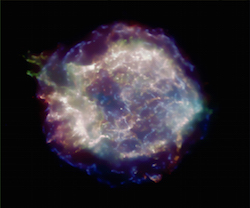
The young supernova remnant, Cas A, observed with the Chandra X-ray telescope. The color coding is for energy. Note the bright white spot in the center – that's the neutron star's surface blackbody radiation. This supernova occurred only a little over three hundred years ago, so the neutron star is quite hot. Chandra has been measuring the cooling over the last ten years. (Read the descriptions of the two links above.)

This is an optical and X-ray composite of the Crab Nebula pulsar (just under 1000 years old). You can see the nebula expanding. This is my favorite image of the Crab. And here's one I took with Astro 16 students last semester. There are several Chandra movies of the pulsar, too.
By the way, if you want to figure out the scale of the pulsar image, above, the background/foreground stars in the image show you HST's resolution of about 0.1 arcsecond.
posted 2/28
This week's assignment is about degeneracy, white dwarfs, and neutron stars.
Week 6
posted 2/25

New: Take a look at these movies of models of pulsation modes (courtesy of Rich Townsend, U. Wisconsin): p-mode, g-mode, and mixed.
Take a look at these excellent images of the Sun:

Andrew's description and the source:
High Altitude Observatory

Catherine's description and the source:
Solar Dynamics Observatory
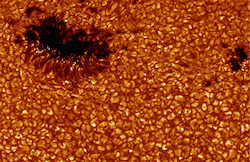
Jamie's description
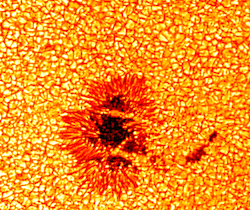
Rebeka's description and the source:
SixDay Science
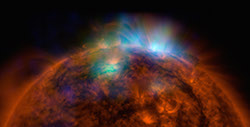
David's description
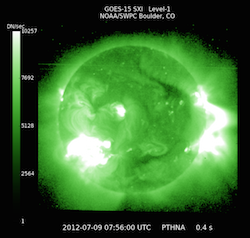
Stefan's description and the source:
GOES Solar X-ray Imager
posted 2/22
The discussion forum for posting questions about the Basu paper is now open.
posted 2/21
This week's assignment focuses on the Sun and includes reading Ch. 11 and also reading a short conference paper called, "What has helioseismology taught us about the Sun?" It is easily found on ADS - I find that searching by author name is a good way to find a particular paper.
posted 2/19
Some reading (and viewing) on post-main-sequence evolution and on massive star formation: (1) The rapidly evolving star, V838 Mon and (2) Simulations of massive star formation [paper and movie].
Week 5
posted 2/16
This week's assignment includes three short problems due on Tuesday. In seminar, we'll wrap up stellar interiors by looking at solutions to the structure equations and our understanding of the main sequence – including the upper mass limit determined by the Eddington parameter. The structure of a given star changes as it evolves beyond the main sequence, which is the subject of Ch. 13.
Week 4
posted 2/8
The first part of the assignment for week 4 focuses on energy sources (including gravity). More questions will be posted soon. Update: The full assignment is now available. Note that nothing in the partial assignment has changed; the new stuff starts at the ? before question 8. Also note that solutions to questions 3, 7, and 10 are due on Tuesday at noon. Finally, we won't get to the last stuff in Ch. 10 this week. We'll save the Lane-Emden equation and the Eddington luminosity for next week.
Week 3
posted 1/31
The assignment for week 3 has two problems you have to hand in on Tuesday. I will likely add a couple more problems over the weekend. Also, I've scanned this week's reading for you. Update 2/2: the complete assignment is now available. I've added just one more problem, which involves writing a small line-profile plotting program. Nothing new to hand in.
Week 2
The assignment for week 2 has a few problems you have to hand in on Tuesday.
Week 1
You will read Ch. 3 in Ostlie & Carroll and also review a particular topic from Astro 16 and give a presentation on it in seminar. Read the assignment and presentation guidelines and topic choices [pdf] and then sign up for a Tuesday time slot to meet with David to go over your presentation.
Week 0
posted 11/24
We will have weekly assignments that more or less alternate between textbook reading and research and review paper reading; and between worked problems and topic presentations.
The first week's assignment will be sent out the last week of winter break.
Return to the main class page.
This page is maintained by David Cohen
cohen -at- astro.swarthmore.edu
Last modified: May 9, 2015